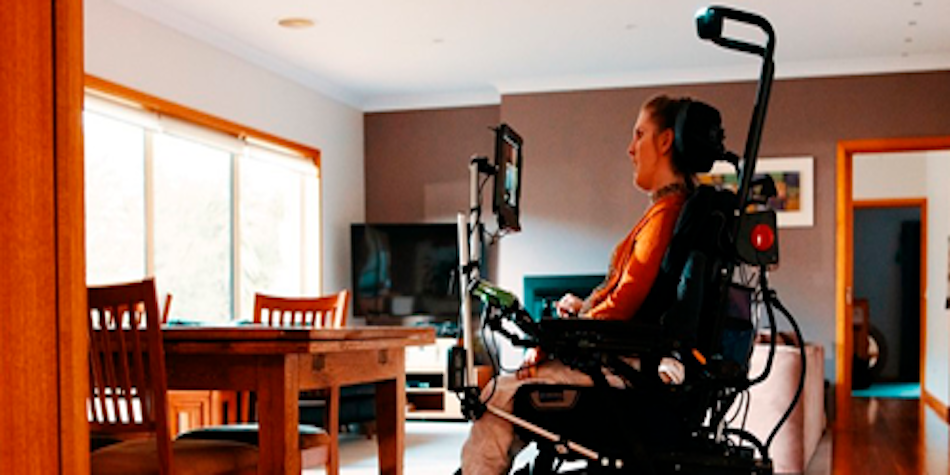Deakin University’s Applied AI Institute (A2I2)has partnered with Australian med-tech pioneers, Control Bionics to develop the world’s first autonomous driving wheelchair module for use in the home. The DROVE module allows users of electric wheelchairs to navigate their homes safely and precisely, offering a new level of independence for individuals with restricted mobility.
When the doorbell rang at Brodie Shaw’s home, she used to have to stay in her wheelchair and wait for someone to tell her who was at the door.
Now, with the launch of the world’s first autonomous driving wheelchair module for the home, Brodie can travel up the hall and see for herself. It’s a small freedom, but the smile on her face tells us everything we need to know about the difference this new technology can make.
The word Brodie used to describe how it feels to have her wheelchair navigate around her home without assistance was ‘calm.’ It’s this feeling of independence and confidence that the DROVE module brings to users like Brodie – transforming everyday activities and empowering them to do more for themselves.
World-first technology for greater independence
The DROVE module, developed by A2I2 in collaboration with Control Bionics, is the first of its kind in the world. It can be added to a user’s electric wheelchair and enables precise navigation within the home environment. The module allows wheelchairs to travel safely to any location in the home, with accuracy down to the centimetre.
The DROVE technology integrates seamlessly with Control Bionics’ NeuroNode wireless sensor device, giving people with restricted movement from conditions like cerebral palsy, motor neurone disease, multiple sclerosis or spinal cord injuries the ability to move more freely within their own space.
Dr Srikanth Thudumu the project lead at A2I2, explained that one of the major challenges was to overcome the limitations of traditional joystick-controlled models of electric wheelchairs. The DROVE module offers a more user-friendly and autonomous navigation experience. To make this possible, A2I2 developed a state-of-the-art digital twin, which provides a virtual representation of a user’s home. This interface allows users to select their destination, while the advanced control system ensures safe and precise navigation.
The DROVE module can navigate tight doorways and hallways, reverse when necessary and detect and stop for unexpected obstacles. The system even ensures that the wheelchair is always in the correct position, making everyday tasks easier and more convenient. Additionally, an override mechanism is built into the system, allowing users to regain manual control at any time.
At A2I2, we developed a state-of-the-art digital twin with a user interface that displays a virtual representation of a user’s home. This interface enables users to select a destination, while our advanced control system ensures safe navigation within the home environment.
Dr Srikanth Thudumu
Senior Research Fellow, Applied Artificial Intelligence Institute
A successful collaboration
The development of the DROVE module highlights the power of collaboration between industry and research. Control Bionics is a leading innovator in the assistive technology sector, known for creating devices that help individuals with complex communication and physical needs. They worked with Deakin’s A2I2 to leverage their AI and robotics expertise, with the A2I2 team providing testing and ensuring the technology met the highest standards.
Lester Lo, Product Executive at Control Bionics, praised the A2I2 team for their technical expertise and smooth collaboration, saying, 'The A2I2 team quickly understood the technology and completed their testing independently, bringing a depth of knowledge to the process.'
The development of DROVE was supported by an Australian Government Innovation Connections grant facilitated by CSIRO, as part of the SME Connect program, which helps Australian start-ups and small to medium enterprises bring innovative ideas to life.
Angela Wu, a facilitator at CSIRO’s SME Connect program, expressed her excitement about being part of the project, stating, 'The launch of DROVE is a testament to Australia’s talented research community and innovative companies. It’s a shining example of what can be achieved when we use technology to change people’s lives for the better.'
Transforming lives through AI-driven solutions
As assistive technologies continue to advance, the possibilities for individuals with limited mobility grow exponentially. The DROVE module offers a transformative solution for wheelchair users, improving their ability to move freely in their own homes and enhancing their quality of life.
Accessible through the National Disability Insurance Scheme (NDIS), the DROVE module is not only a major breakthrough in assistive technology but also a reflection of the power of collaboration between academia and industry to solve real-world problems. It shows how AI-driven innovations can provide users with the freedom they deserve, opening up new possibilities for independence and improved well-being.
For more information about this project, contact Dr Srikanth Thudumu.

